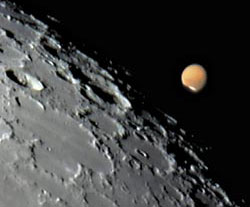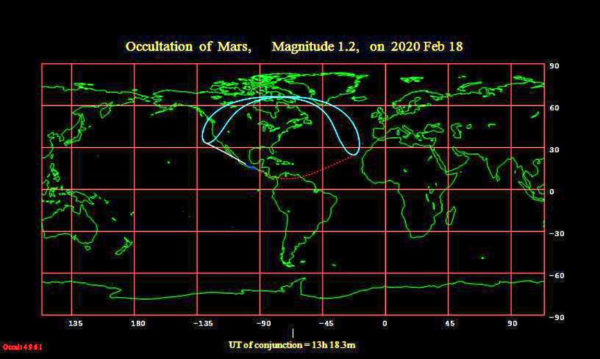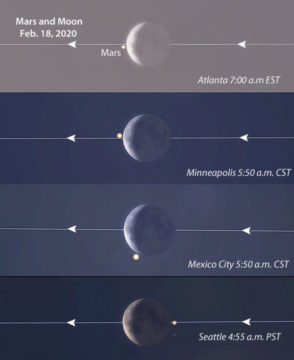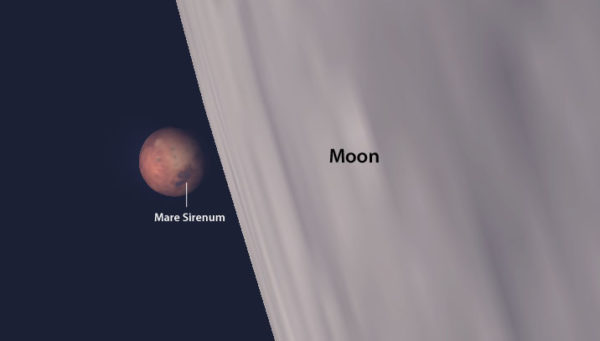On Tuesday February 18th the Moon will pass in front of Mars occulting the Red Planet around or just before sunrise for viewers in North America.

There are five lunar occultations in 2020 that involve Mars, but February's will be the only one visible in the U.S. and Central America. The others take place in March, August, September, and October, and are all mostly visible in the Southern Hemisphere (September's event will also be accessible to viewers in northern Africa and southernmost Europe).
On February 18th, the planet will be 92% illuminated, 5.2″ in apparent diameter, and shine at magnitude 1.2 when it meets the Moon less than 1° north of the Lagoon Nebula in Sagittarius.
https://www.youtube.com/watch?v=aMbWe8b0ReQ&t=84s
The December 24, 2007, occultation of Mars seasoned with rock music.
The planet's apparent diameter at the time was 15.8″. Action starts at the 1:22 mark.
In a stellar occultation the Moon slowly sneaks up on a star and sucks it from sight in a tiny fraction of a second. The suddenness of the disappearance, also called immersion, can take your breath away. Occultations occur in literally a blink of the eye because stars are so far away that they’re essentially points of light. Coupled with the fact that the Moon has next to no atmosphere, a star remains bright right up to the Moon's edge and then vanishes in an instant. The celerity with which this happens is also a reminder of just how fast the Moon is traveling in its orbit, averaging 3,680 kilometers per hour.
Mars is different. It presents a small disk, so it will take the Moon about 14 seconds to swallow the Red Planet start to finish. Disappearance occurs at the bright limb and reappearance at the trailing, or dark, limb. The time between disappearance and reappearance, or emersion, depends on how centrally the Moon and planet cross, and can vary from minutes to about an hour and a half, depending on your location. Visually, we'll witness a beautiful Mars-set at the approaching limb followed by what promises to be a spectacular Mars-rise at the darkened, earthlit limb when the planet reemerges.

Locations in the eastern U.S. will see Mars disappear shortly after sunrise and reappear in a full daylight sky. While the dark limb won't be visible after sunrise, a telescope may still show the just-discernible planet upon emersion. Midwestern observers will see the disappearance during twilight and reappearance around sunrise. Cities in the far West will miss the disappearance entirely because the Moon won't have risen yet. But lucky observers will see Mars emerge in dramatic fashion from the Moon's earthlit edge in a dark sky.
From U.S. latitudes the occultation occurs with the pair low in the southeastern sky, so be sure your observing location has a clear view in that direction. Click here for times in Universal Time (UT) of the planet's disappearance and reappearance for hundreds of cities in the occultation zone. To convert UT to your time zone subtract 5 hours for EST; 6 hours for CST; 7 hours for MST; and 8 hours for PST. Here's a sample of U.S. cities and disappearance / reappearance times:
New York City, NY — 7:36:37 a.m. / 9:05:49 a.m. EST
Atlanta, GA — 7:07:29 a.m. / 8:45:13 a.m. EST
Columbus, OH — 7:14:47 a.m. / 8:45:48 a.m. EST
Nashville, TN — 6:04:12 a.m. / 7:38:49 a.m. CST
Chicago, IL — 6:07:10 a.m. / 7:35:02 a.m. CST
Kansas City, MO — 5:52:48 a.m. / 7:20:43 a.m. CST
Phoenix, AZ — 4:37:27 a.m. / 5:40:07 a.m. MST
Boise, ID — Reappearance only at 5:49:02 a.m. MST
San Francisco, CA — Reappearance only at 4:30:57 a.m. PST
Seattle, WA — Reappearance only at 4:47:41 PST

Stellarium
You can also prognosticate your specific viewing circumstances by simulating the occultation using a free star-charting program like Stellarium for Windows or Mac. Select your location and set the date to February 18th and the time near the start of the occultation. Select the Sky and Viewing Options icon on the lower left side of your screen, click on the SSO tab, and make sure the Scale Moon box is unchecked. Close down the dialog box, and then click the magnifying glass icon (search function) and type in "Mars." Advance the time minute by minute until Mars touches the lunar limb and note the time. (You can also zoom in to see better.)
While Mars is relatively bright it's unlikely the immersion will be visible without optical aid. Binoculars should handle this with aplomb, but a telescope will prove the better choice if for no other reason than it sits still, making it more comfortable to watch the action. If you live in the western half of the occultation zone, Mars will reappear at the dark limb in early twilight or darkness and should be readily visible with the naked eye as it extricates itself from the lunar limb.

If you're watching with a telescope I recommend using the highest magnification seeing conditions will allow. Make Mars BIG, the better to experience the drama unfolding before your eyes.
Consider photographing the event, too. You can take great photos just by holding your cell phone over the telescope eyepiece. Take a series of images as the Moon approaches Mars, slowly engulfs it, and then releases the planet. Stack them together in sequence in an easy online gif-maker like this one and you've got yourself a cool animation you can share with Sky & Telescope or on your Facebook page. Clear skies!
 0
0
Comments
Tom Hoffelder
February 12, 2020 at 6:18 pm
This sounds really cool, except, per my calculations, for all of us in the Northeast, between Washington DC and Boston, it happens a half hour to an hour after sunrise, not before?
You must be logged in to post a comment.
Bob KingPost Author
February 12, 2020 at 8:16 pm
Hey Tom,
Don't let that stop you. I observed an Aldebaran occultation after sunup about a year ago. As long as your sky is clean and blue you should be able to watch it disappear at the bright limb shortly after sunrise. Good luck!
You must be logged in to post a comment.
Tom Hoffelder
February 13, 2020 at 10:10 am
Thank you Bob! Weather will probably be the real problem; current forecast for Tue morn here in Maine is snow. But our forecasts change hourly!
You must be logged in to post a comment.
Terry-Richardson
February 15, 2020 at 7:16 pm
Tom,
Bob is right, don't let post sunrise planet viewing dissuade you. One of the best periods of observation of Mars happened for me in 2004. The seeing was one of my best ones ever at sea level. I called an astro friend and woke him up at 4 AM to get a view of Mars. We watched until over an hour after sunrise. Without the stark contrast of a black sky, details on the surface of the planet seemed easier to distinguish. I am told planet visual observers know this secret but I had not learned.
You must be logged in to post a comment.
Rod
February 13, 2020 at 8:55 am
Bob, Rod in Maryland checked Stellarium 0.19.3 and Starry Night Pro Plus 8. This looks good for my location and I could start viewing Mars and the Moon near 0721 EST very close in angular separation, sunrise near 0654/0655 EST for the 18th. My 90-mm refractor could show, I have enjoyed views of Mars in the early morning sky and tracked after sunrise this winter. The altitude at my location will be near 26 degrees and azimuth near 164/165 degrees when viewing. The weather forecast however, looks bad. Partly Cloudy skies Monday night here and mostly cloudy in the morning on the 18th, awful 🙂
You must be logged in to post a comment.
Jerry-Korol
February 13, 2020 at 10:15 am
Hello, I believe that the time you list for Boise is off by an hour...
You must be logged in to post a comment.
Bob KingPost Author
February 13, 2020 at 10:47 am
Hi Jerry,
Thank you for pointing that out. Now fixed.
You must be logged in to post a comment.
StarGeezer
February 13, 2020 at 1:56 pm
Hey, Bob, Enjoy your articles and style. Check your list of cities. I believe Atlanta is still in GA! If it somehow has moved to NC would that be close to Mayberry??? Unfortunately WX has been 100% overcast and raining for days and that's the forecast here in southern Indiana for Tuesday morning. However, friends are vacationing in Mexico next week, Tulum south of Cancun and I've prepped them on observing the occultation. They may get a "grazer". Clear skies! Mark Steven Williams, StarGeezer Astronomy
You must be logged in to post a comment.
Bob KingPost Author
February 13, 2020 at 6:09 pm
StarGeezer,
Ha! That was originally supposed to be Charlotte, hence the lingering "NC." At the last minute I decided to go a little further south and choose a more heavily populated metro area. There you have it, and thank you for alerting me.
You must be logged in to post a comment.
Bob
February 18, 2020 at 3:28 am
Bob,
Nice article on the occultation of Mars.
For those interested, the timeanddate.com website has several calculators and graphs to help identify the various twilight times at your observing location (astronomical, nautical, and civil twilight).
As for my location here in Kentucky, cloudy...showers...rain later this morning.
You must be logged in to post a comment.
Rod
February 18, 2020 at 8:44 am
Bob King et al. Here is my report from my location in Maryland. I did observe this morning 0645-0745 EST. Sunrise 0654 EST. Low level clouds moving quickly by from the south did block my views at times. Blue sky above with scattered cirrus and altocumulus layers. I used the TeleVue 32-mm plossl with my 90-mm refractor telescope and 10x50 binoculars. Clouds blocked my view of the Moon from 0723 EST until 0738 EST. When I viewed again at 0738 EST, Mars no longer visible near the lunar limb. From 0700 until 0723 EST, I did enjoy some good views of bright, orange Mars near the waning crescent Moon limb. At 0723 EST, the Moon and Mars very close in angular separation before the occultation. North up, mirror reverse view so the limb of the Moon and Mars was on right side of the FOV. 31x and nearly 1.6-degree true FOV. At 0716 EST, I could just barely see Mars near the lunar limb using my 10x50 binoculars. However, the 90-mm refractor view at 31x was excellent - clouds permitting. This was great fun this morning. At least I was able to see some of the occultation event but not the occultation itself. The Moon quickly closed the gap between the lunar limb and Mars while I viewed.
NWS reports winds aloft at 3000 feet for my location were 180/32 knots so lower level clouds came moving by quickly, blocking the view at times. High above, large areas of blue sky with cirrus and altocumulus. Winds at 30,000 feet this morning, 270/85 knots. I used lower power and wider field views with the telescope because of the clouds moving by. However, even at 31x, Mars and the Moon very easy to see, even at times through passing clouds, a good photo opportunity for some who do that.
You must be logged in to post a comment.
Anthony Barreiro
February 18, 2020 at 2:15 pm
I got up at 3:30 am PST and went outside to check the sky. Lots of stars visible through broken altocumulus clouds, so it seemed worth walking up Bernal Hill to watch Mars emerge from occultation. As I was walking up the hill the clouds thickened, and by the time I got to the top of the hill much of the sky, including the entire southeastern quadrant, was clouded over (Leo, Bootes, and western Virgo were completely clear). I could barely see the glow of the Moon through the clouds, and occasional glimpses of part of the Moon's bright limb through binoculars. Forty minutes after the end of the occultation there was a nice break in the clouds and I could see Mars twinkling about a quarter degree west of the Moon's dark limb -- a beautiful sight on its own terms, even if it wasn't everything I was hoping for. Jupiter and a couple of his Moons, too. And a couple of coyotes, fearlessly prowling for rodents in this wild little park in the middle of San Francisco. All in all it was a nice walk, and when I got home I was able to sleep for an hour before I had to get up and go to work.
You must be logged in to post a comment.
Anthony Barreiro
February 19, 2020 at 1:37 pm
Of course this morning, a day after the occultation, was perfectly clear. I got my first telescopic views of Jupiter and Saturn during their current apparitions. Hopefully the first of many more as they're on their way to nearly simultaneous oppositions to the Sun in July and a remarkably close conjunction next December.
You must be logged in to post a comment.
Dan Shipley
February 19, 2020 at 12:01 pm
Question about film clip in article from 2007, previous occult of Mars.
Moon passing between us on earth and Mars.
Sunlight on part (about half) of moon
How come we can see Mars till it goes behind the lighted part of the moon????
Wouldn’t the dark part of the moon block us from seeing Mars????
Watch film clip close to start of the article.
https://www.skyandtelescope.com/astronomy-blogs/watch-the-moon-occult-mars-before-sunrise-on-february-18th/
You must be logged in to post a comment.
Bob KingPost Author
February 19, 2020 at 12:23 pm
Hi Dan,
Thanks for your question. Actually that occultation occurred when the moon was nearly 100 percent illuminated — a full moon. It only looks like a half-moon because the view is highly magnified, and you're seeing the edge of the field of view (along the left side) which cuts off the remainder of the moon. I hope this helps to answer your question.
You must be logged in to post a comment.
You must be logged in to post a comment.